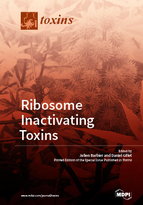Ribosome Inactivating Toxins
A special issue of Toxins (ISSN 2072-6651).
Deadline for manuscript submissions: closed (1 September 2017) | Viewed by 134341
Special Issue Editors
Interests: ricin; Shiga toxins; bacterial toxins; retrograde transport; toxin inhibitors
Special Issues, Collections and Topics in MDPI journals
Interests: bacterial toxins; diphtheria toxin; ricin toxin; Shiga toxins; botulinum toxins; intracellular trafficking; biodefense; toxin inhibitors; antitoxin drug development
Special Issues, Collections and Topics in MDPI journals
Special Issue Information
Dear Colleagues,
Ribosome inactivating proteins (RIPs) form a vast family of hundreds of toxins from plants, fungi, algae and bacteria. RIP activities have also been detected in animal tissues. They exert an N-glycosydase catalytic activity that is targeted to a single adenine of a ribosomal RNA, thereby blocking protein synthesis and leading intoxicated cells to apoptosis. In many cases they have additional depurinating activities that act against other nucleic acids, such as viral RNA and DNA, or genomic DNA. Although their role remains only partially understood, their functions may be related to plant defense against predators and viruses, plant senescence or bacterial pathogenesis.
Most RIPs are no threat to human or animal health. However, several bacterial RIPs are major virulence factors involved in severe epidemic diseases such as cholera, dysentery or the hemolytic uremic syndrome that may occur in patients suffering from Shiga toxin-producing entero hemorrhagic Escherichia coli infection. A few RIPs synthesized in plant seeds have been involved in accidental or criminal poisonings, political intimidation or bio-suicides. Tremendous progress has been made in their detection, identification and characterization. However, the pathophysiologies of these intoxications seem much more complicated than being solely linked to cell death and are still far from being understood. There are no commercially available products to specifically prevent or block RIP action, although research progress has been made in the development of antibodies, small molecule inhibitors and vaccines.
Finally, RIPs have been engineered into immunotoxins by conjugating them to antibodies or other targeting moieties. Numerous clinical trials have shown great promise, as well as the difficulties in developing such therapies to destroy cancer cells.
This Special Issue of Toxins presents the most recent data on all the aspects of RIPs: new RIPs, structure, function, mechanism of action, pathophysiology, anti-RIP drug development and RIP engineering into anticancer treatments.
Prof. Dr. Daniel Gillet
Dr. Julien Barbier
Guest Editors
Manuscript Submission Information
Manuscripts should be submitted online at www.mdpi.com by registering and logging in to this website. Once you are registered, click here to go to the submission form. Manuscripts can be submitted until the deadline. All submissions that pass pre-check are peer-reviewed. Accepted papers will be published continuously in the journal (as soon as accepted) and will be listed together on the special issue website. Research articles, review articles as well as short communications are invited. For planned papers, a title and short abstract (about 100 words) can be sent to the Editorial Office for announcement on this website.
Submitted manuscripts should not have been published previously, nor be under consideration for publication elsewhere (except conference proceedings papers). All manuscripts are thoroughly refereed through a double-blind peer-review process. A guide for authors and other relevant information for submission of manuscripts is available on the Instructions for Authors page. Toxins is an international peer-reviewed open access monthly journal published by MDPI.
Please visit the Instructions for Authors page before submitting a manuscript. The Article Processing Charge (APC) for publication in this open access journal is 2700 CHF (Swiss Francs). Submitted papers should be well formatted and use good English. Authors may use MDPI's English editing service prior to publication or during author revisions.








